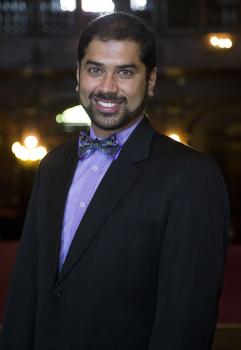Dr. Kantak Receives Grant to Study Stroke Hand Function Recovery

How often do you use one hand to complete an activity? Not often, according to Dr. Shailesh Kantak, assistant professor of Physical Therapy. The dependency on using both hands to complete most tasks of daily living– from putting on socks in the morning to pulling up the bedsheets at night– is what has spurred his desire to help stroke victims recover functionality on the side that has been weakened.
In support of this research, Dr. Kantak has received a five-year National Institutes of Health (NIH) grant for the approximate amount of $1.9 million for the project “Perceptual motor interaction to improve bimanual coordination after stroke.” The University received a sub-award of $274,281 from the total grant. Conducted at Moss Rehabilitation Research Institute, where Dr. Kantak is director of the Neuroplasticity and Motor Behavior Laboratory, this research will use different strategies to encourage bimanual coordination between the two hands of a stroke victim to increase strength and function in the weaker hand.
“Rehab often focuses on the use of the good arm with constraint movement therapy, a unimanual practice that restrains the dominant hand to improve the weakened hand,” said Dr. Kantak. “However, studies show this does not help everyone. Further, the unimanual therapies do not improve the use of the arm in the real world. There’s a disconnect– I think the missing link is because most of our movements are bimanual.”
Dr. Kantak hopes implemented virtual reality strategies will force patients to engage their weaker hand, and in turn enable them to have coordinated bimanual use when they’re outside of physical therapy.
“I love patient care and science,” said Dr. Kantak. “I want to understand how can I make things better for my patients, and it drives my work. If we want to be effective therapists, we need to go back to the science– we cannot just follow technique alone without knowing the science.”

